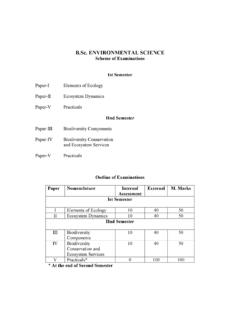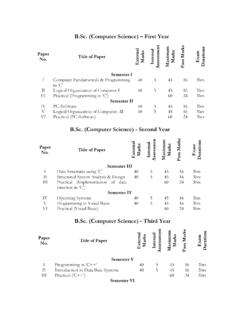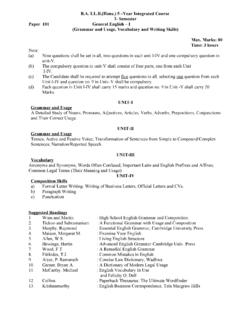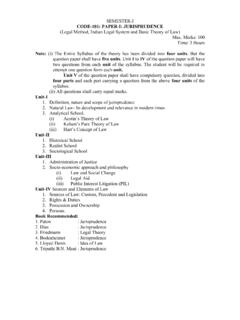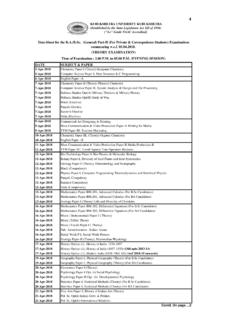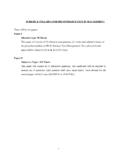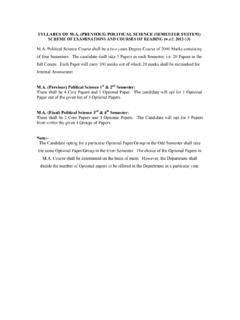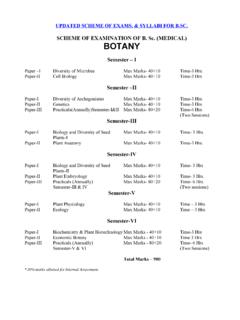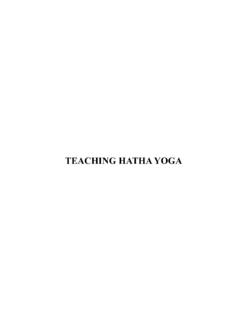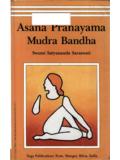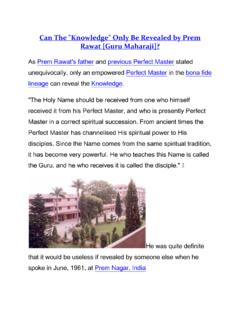Transcription of SYLLABUS FOR P.G DIPLOMA IN YOGA COURSE …
1 SYLLABUS FOR DIPLOMA IN yoga COURSE ( one year ) theory examination Sr. no subject theory marks Internal Marks Total marks Paper- 1 Yog Parichaya 80 20 100 Paper-II Anatomy, Physiology for Yogic Practice. 80 20 100 Paper-III Teaching Methodology of Yogic Practice. 80 20 100 Paper-IV Traditional yoga 80 20 100 320 80 400 Practical Sr. no subject Practical marks Internal Marks Total marks V Practical Demonstration of Asanas Pranayam, Shudhi Kriya (Practical Note Book) & viva-voce 80 20 100 VI Practice of teaching five lessons Plan on any skill (three asanas one pranayama & one kirya) on lesson format with chart & viva-voce 80 20 100 160 40 200 Paper- I YOG PARICHAYA External Marks : 80 Int.
2 Ass. 20 Time : 3 hours Note: The question paper consists of five units unit Ist, IInd. ,IIIrd., IVth. and Vth. The Unit Ist., IInd., IIIrd. and IVth consists of two questions from each unit(I to IV) carrying 15 marks each and unit Vth consists of ten short answer questions covering the whole SYLLABUS carrying 2marks each. The candidates are required to attempt one question from each unit(I to IV) and unit Vth is compulsory for all. UNIT-I (i) Origin of yoga & its brief development. ii) Meaning of yoga & its importance iii) yoga as a Science of Art ( yoga Philosophy). iv) Meaning of meditation and its types and principles. UNIT- II i) Classification of yoga /Types of yoga ii) Hatha yoga , Raja yoga , Laya yoga , Bhakti yoga , Gyan yoga , Karma yoga .
3 Iii) Asthang yoga . UNIT -III i) Principles of Yogic Practices. ii) Meaning of Asana, its types and principles. iii) Meaning of Pranayama, its types and principles. iv) Meaning of Kriya its types and principles. UNIT -IV i) Yogic therapies and modern concept of yoga ii) Naturopathy, Hydrotherapy, Electrotherapy, Messotherapy, Acupressure, acupuncture. iii) Meaning and importance of prayer. iv) Psychology of mantras. v) Different mudras during prayers. UNIT V CONTENTS: Short type of 10 questions selected from I to IV units. Each have 2 marks and all are compulsory.
4 PAPER-II ANATOMY PHYSIOLOGY FOR YOGIC PRACTICES External Marks : 80 Int. Ass. 20 Time : 3 hours Note: The question paper consists of five units unit Ist, IInd. ,IIIrd., IVth. and Vth. The Unit Ist., IInd., IIIrd. and IVth consists of two questions from each unit(I to IV) carrying 15 marks each and unit Vth consists of ten short answer questions covering the whole SYLLABUS carrying 2marks each. The candidates are required to attempt one question from each unit(I to IV) and unit Vth is compulsory for all. UNIT-I i) Introduction of human body and its systems. ii) Definition of Anatomy and Physiology and importance in Yogic Practices iii) Respiratory System iv) Digestive System v) Endocrine System UNIT-II i) Classification of Asanas and its Mechanism.
5 Ii) Cultural Asana(standing, sitting, supinline, praline position & topsy-turvy) iii) Meditative Asana and Relaxative Asana vi) Nervous System vi) Circulatory System UNIT-III i) Introduction of Kriya, Bandha and Mudra. ii) Importance of Kriya and its scientific approach. iii) Importance of BANDHA and its scientific approach. iv) Importance of MUDRA and its scientific approach. UNIT-IV i) Effect of Asanas on various Systems ii) Difference between Asana and Exercise. iii) Difference between Pranayama and deep breathing. iv) Yogic Diet. UNIT V CONTENTS: Short type of 10 questions selected from I to IV units. Each have 2 marks and all are compulsory. PAPER-III TEACHING METHODOLOGY OF YOGIC PRACTICE External Marks : 80 Int.
6 Ass. 20 Time : 3 hours Note: The question paper consists of five units unit Ist, IInd. ,IIIrd., IVth. and Vth. The Unit Ist., IInd., IIIrd. and IVth consists of two questions from each unit(I to IV) carrying 15 marks each and unit Vth consists of ten short answer questions covering the whole SYLLABUS carrying 2marks each. The candidates are required to attempt one question from each unit(I to IV) and unit Vth is compulsory for all. UNIT -1 i) Meaning and types of methods. ii) Factors affecting teaching. iii) Principles of teaching. iv) Need and importance of teaching practice. v) Maxims of teaching UNIT-II i) Presentation technique ii) Technical preparation.
7 Iii) Personal preparation. iv) Modern concept and teaching Aids class management and its meaning and need v) Steps of class management UNIT-III i) Meaning of tournaments and competition and its importance. ii) Eligibility rules of Inter University of yoga . iii) Organisation and administration of Yog competition. iv) Audio visual Aids. UNIT-IV i) Meaning of lesson plan and its importance. ii) Principles of lesson plan iii) Demonstration in yoga and its types iv) Importance of demonstration. UNIT V CONTENTS: Short type of 10 questions selected from I to IV units. Each have 2 marks and all are compulsory. PAPER-IV TRADITIONAL yoga External Marks : 80 Int.
8 Ass. 20 Time : 3 hours Note: The question paper consists of five units unit Ist, IInd. ,IIIrd., IVth. and Vth. The Unit Ist., IInd., IIIrd. and IVth consists of two questions from each unit(I to IV) carrying 15 marks each and unit Vth consists of ten short answer questions covering the whole SYLLABUS carrying 2marks each. The candidates are required to attempt one question from each unit(I to IV) and unit Vth is compulsory for all. UNIT -1 Patanjali Yog Sutra i) Definition and meaning of yoga . ii) Types of vritties. iii) Different ways to achieve Raj Yog. iv) Disturbance inYogic Practices. UNIT -II Swatmaram Hatha Pradipika.
9 I) Asanas. ii) Pranayama iii) Kriyas. iv) Nadanusandhan UNIT -III Great Philosophy of Indian yoga Culture ii) Charwak. ii) Budha. iii) Mahavir. iv) Swami Vivekanand UNIT -IV i) Panchikaran Prakriya. ii) Panch Kosh theory . iii) Nandha Bhakti iv) Kundalani. v) Astha Sidhi UNIT V CONTENTS: Short type of 10 questions selected from I to IV units. Each have 2 marks and all are compulsory. PRACTICAL (V) Practical Demonstration of Asana, Pranayam and Shudhikriyas Marks : 100 (Internal :20 marks ) (External : 80 marks) LIST OF YOGIC PRACTICES ASANA PRANAYAMA KRIYA 1. Shirsh Asana 1. Anulome-vilome Any two Kirya from the followings:- 2. Vipratakarani 2.
10 Ujjai 1. Neti 3. Hal Asana 3. Bhastrika 2. Dhauthi 4. Bhujang Asana 4. Shitali 3. Tratak 5. Ardh-Shalbh Asana 5. Sitkari 4. Nauli 6. Vakra Asana 6. Suryabhedan 5. Kapalbhati 7. Ardha Matasyaendrasana 7. Bhramri 8. Paschimottan Asana 9. Vajra Asana 10. Supta Vajra Asana 11. yoga Mudra 12. Nauka Asana 13. Bak Asana 14. Mayur Asana 15. Ustra Asana 16. Vriksh Asana 17. Padma Asana 18. Trikon Asana 19. Sarvang Asana 20. Manduk Asana 21. Pavan Muket 22. Chakra Asana 23. Pad-hast Asana 24. Katichakra Asana. 25. Surya Namaskar Note: Students are required to do any 15 of above mentioned Asanas, two Pranayama and two Kriya. i) Note Book (ii) Viva-voce Paper-VI Marks : 100 (Internal :20 marks ) (External : 80 marks) Practical Teaching Practice Practice of teaching of five lesson plan on any skill (Three asanas, one Pranayama and one Kriya) on lesson format with chart and Viva-voce.
